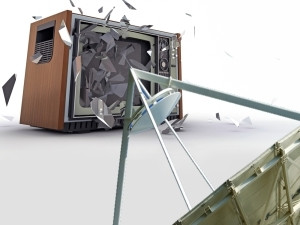
The rise of satellite broadcast offerings in SA, bolstered yesterday by Sentech's launch of an open access platform, will be the death of local digital terrestrial television.
On the back of OpenView's pending October launch of a no-subscription satellite offering, Sentech has rebranded its failed Vivid platform as Freevision, and will make the open access platform available to third-party service providers to offer more choice to viewers.
Commentators say this move, and that by OpenView, negates the country's shift towards digital migration - which has already cost Sentech millions in upgrading its network - as consumers will opt for more choice on satellite.
Although digital television has yet to launch commercially, a prospect mooted for what is left of this year, the change should see the launch of new channels and offerings. However, what viewers will be able to watch in the heavily-regulated terrestrial segment has yet to be made clear.
Taking the gap
SA has been moving towards digital television since 2006, when the state inked an agreement to move off analogue in line with the International Telecommunication Union's decision to stop protecting analogue by the middle of 2015.
However, the process has been beset by several delays, and satellite operators, such as OpenView, are taking advantage.
Yesterday, Sentech announced Freevision would be its in-fill solution to cover the 12% of SA's population that do not have access to television via antennae. However, commentators see the rise of satellite as a threat to SA's digital plans. Vivid has about 60 000 subscribers.
There are 14.4 million households in SA, of which 74.5% have a television, but 12% of these - or 1.7 million homes - would not be able to view television, because the terrestrial network does not extend to those areas.
There are some geographically challenging parts of SA that make it commercially unviable to roll out a terrestrial network. Freevision is meant to fill this 12% gap, but is also open to other content providers.
Freevision is located at 68.5^0E on Intelsat 20 - the largest video neighbourhood in sub-Saharan Africa, with an estimated 60 million viewers, making it widely available. As a result, most local viewers will not have to install a second dish, or move their current one.
No point
Kate Skinner, from the SOS coalition, which aims to support public broadcasting, says satellite services are filling the gap that has been created by the delays in launching digital terrestrial television (DTT). "It will make it more and more difficult to get people to purchase DTT STBs [set-top boxes] when they finally hit the market."
Skinner points out that if the decoder for Sentech's satellite service is about the same price as the one that will be needed for digital television, people will opt for the satellite service, as it will offer more content.
Sentech has confirmed Freevision will be open to providers to offer television via satellite, although they will not be able to showcase their offerings via the terrestrial network. Licensed broadcasters that will make use of DTT get their offerings distributed via satellite at no extra charge.
Sentech CEO Setumo Mohapi says the company believes the "unique broadcasting signal distribution network design" makes sure it uses its publicly-funded budget efficiently and ensures multichannel broadcasting signal distribution tariffs are affordable, which will encourage the entry of small, medium and micro enterprises into the television broadcasting sector.
Skinner says the rise of satellite brings into question the point of moving to DTT instead of just switching to satellite. OpenView's offering is for a decoder and a dish at just under R2 000, while Sentech has yet to release its set-top box pricing and detail what channels will be available.
Viewers now have much more of an option, says Skinner. She notes there is DStv's R99-a-month offering, and OpenView will launch soon, and now there is Sentech's product.
Marc Schwinges, vice-chairperson of the SA Screen Federation, points out that the satellite space is less regulated than the terrestrial arena. He says OpenView is likely to have much more on offer than what is currently available in the free-to-air space.
In addition, the battle around conditional access has thrown a spanner into the DTT space, says Schwinges.
The apparent hold-up with digital television - which will provide more channels, better audio and visual, and free up much needed spectrum - is the SABC board's signature to appoint a company to handle conditional access.
Yet, the SABC is not revealing the status of this process and its oversight department, the Department of Communications (DOC), seems confused as to whether conditional access is needed before digital TV can officially go live.
Viewers with access to a set-top box can already pick up the improved signal, but the official launch has been delayed for almost a year, after etv took the DOC to court over who was going to handle conditional access. Now, this issue is in broadcasters' hands, and etv says the matter still has to be sorted out by the SABC board.
Schwinges says, if people can pay R2 000 once for a lifetime of channels, they will go that route. He notes that the department's subsidised offer only applies to 10% of the population.
Government has agreed to cover 70% of the cost of a set-top box, needed to convert the new signal for viewing on older TV sets, for about five million homes. It will also pay for new aerials for those homes, if required.
Those who get the subsidy are likely to stay with terrestrial, says Schwinges. However, he says, those who can afford a decoder will question why they should not just pay a bit more and add a dish to get more channels.
Satellite will have an impact on digital television, it just depends on the offerings, price and marketing, says Schwinges.
Siya Qoza, the DOC's spokesman, notes that the digital broadband migration policy allows for both a satellite and terrestrial rollout. He notes that government has to move off analogue.